A fragrant sauce with ginger, garlic, ketchup and spicy doubanjiang coats crispy pan-fried shrimp in this Ebi Chili recipe.
Ebi Chili is all about the flavorful sauce. This sauce is fragrant from the ginger and garlic. It’s spicy from the Sichuanese doubanjiang. The ketchup takes the sauce over the top by adding layers of umami and sweetness.
And the best thing about this recipe is that it’s a quick, weeknight friendly meal that’s ready in just 20 minutes.
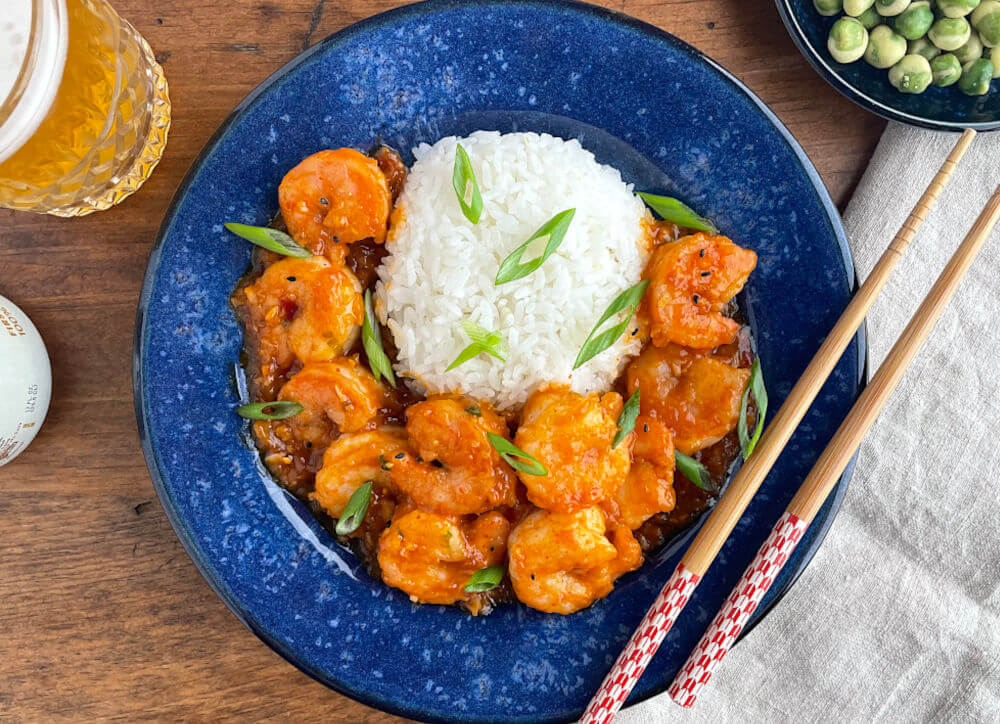
What is Ebi Chili
Ebi Chili is a Chinese-style Japanese dish of crispy pan-fried shrimp in a spicy sauce of ginger, garlic, doubanjiang, ketchup, and other seasonings.
The sauce’s flavor is fragrant and slightly spicy. Since ketchup is a primary ingredient, the sauce has a sweet and acidic tomato flavor.
Ebi Chili is a traditional chuka (Japanese-Chinese) recipe. Chuka cuisine is Japan’s version of Chinese food, adapted by Chinese restaurants in Japan to match the Japanese palette.
Ebi Chili is based on a Sichuanese shrimp recipe. It was first created in the 1950s by Chen Kenmin, an emigrant from Sichuan, who’s regarded as the grandfather of Sichuan cuisine in Japan. He introduced the dish in his Yokohama-based restaurant, Shisen Hanten.
Ingredients
Shrimp. Tender shrimp are marinated in a mixture of sake and cornstarch, and then lightly pan-fried until crisp.
Ginger. A healthy amount of ginger gives the dish a strong fragrance.
Garlic. We’ll use two whole cloves of garlic, giving the sauce a strong garlicky kick.
Scallion. Scallions are fried along with the ginger and garlic to give the sauce an oniony kick.
Ketchup. Ketchup is the primary ingredient of the sauce, giving it a sweet, acidic taste of tomato.
Doubanjiang. The fermented chili bean paste from Sichuan gives the sauce spiciness and depth.
Sugar. Sugar works to tame the heat and round out the flavor with some sweetness.
Sesame oil. Sesame oil gives the sauce a nutty fragrance.
Chicken broth. A half cup of chicken broth gives the sauce more volume.
Sake. Sake has two uses. First, for marinating the shrimp to enhance their flavor and to allow the other ingredients to work their way into the shrimp. Second, we’ll add it directly to the sauce for some additional sweetness and umami.
Cornstarch. We’ll use cornstarch in three ways. First, we’ll use it along with water to wash the shrimp and firm up their texture. Second, it’s used in the marinade to coat the shrimp and help them crisp up when fried. And third, we’ll add it at the end of the stir frying process to thicken up the sauce.
What is doubanjiang?
Doubanjiang is a Chinese condiment from Sichuan province made of fermented broad beans, chilis, soybeans, salt, and flour. Doubanjiang goes by other names such as toban-djan, tobanjiang, or others.
It has a complex flavor profile that’s entirely unique. It’s spicy, slightly sweet, and has a very strong depth of umami.
This ingredient is an absolutely essential part of the Sichuanese pantry, and perhaps the one most important ingredient in Sichuan cooking. It’s what makes Sichuanese food taste Sichuanese.
An important thing to realize about doubanjiang is that there are different levels of quality that highly affect its taste.
A cheap, lower quality doubanjiang won’t taste great and it won’t impact your meal too much. But a higher quality doubanjiang is a thing of beauty. The best doubanjiang comes from Pixian, China. Pixian doubanjiang is a geographical indication protected product, just like Champagne is protected in Champagne, France.
It’s really worth seeking out a high quality doubanjiang and spending a bit more money on it. I promise that the high quality stuff will make a huge difference in your recipes, including in this Ebi Chili.
Ketchup in Japanese food
Ebi Chili, like many other Japanese recipes, uses ketchup.
While ketchup has a bit of a stigma in the West and is seen as just a low quality condiment used to dip your fries, it’s considered a legitimate ingredient in Japan.
Many Japanese recipes incorporate ketchup, and especially recipes from yōshoku cuisine (Western-inspired Japanese food). Spaghetti Napolitan is an example of a Japanese-style pasta that uses a ketchup sauce. Other classics like omurice, tonkatsu sauce, and more also use ketchup.
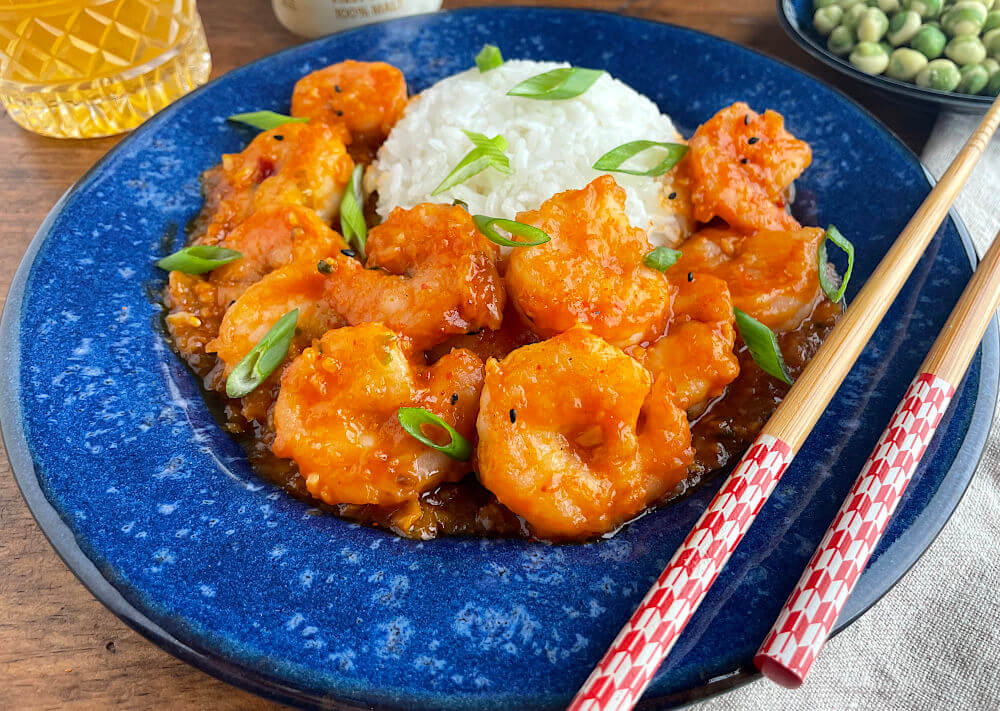
How to make Ebi Chili
- Prepare the shrimp. Remove the tails from the shrimp and devein them if necessary. Next rub the shrimp in 1 tablespoon of cornstarch and then rinse them under cool water to remove all of the cornstarch. This washing process helps improve the texture of the shrimp, firming them up.
- Marinate the shrimp. Marinate the shrimp for 10 minutes in a mixture of salt, white pepper, sake, and cornstarch.
- Fry the shrimp. Heat oil in a wok or frying pan on medium-high heat. Once the oil is hot, add the shrimp to the pan and cook for 1-2 minutes on each side (for a total of 2-4 minutes) until the outsides of the shrimp begin to brown and crisp. Once finished, remove the shrimp from the pan and set aside. The insides of the shrimp do not need to be fully cooked through at this point.
- Make the stir fry. Clean the same wok or pan, return it to medium-high heat, and add fresh oil. Once the oil is hot, add the ginger, garlic, and white parts of the scallion and cook for 1-2 minutes, stirring constantly, until lightly browned. Lower the heat to medium and add the ketchup and doubanjiang. Cook for 1-2 minutes, stirring constantly, until the ketchup and doubanjiang become fragrant. Add the chicken broth, sake, and sugar, and simmer for 2-3 minutes, stirring frequently. Now add the shrimp and the green parts of the scallions, and simmer until the shrimp cook through, about 1-2 minutes. Now add the cornstarch slurry and stir. Cook for 1-2 minutes until the sauce thickens, stirring constantly. Now add the sesame oil, stir, and remove from the heat.
- Serve. Once finished, place the shrimp and sauce on a serving plate and serve.
Tips for making the shrimp
Measure and set aside all the ingredients before you start cooking. Stir frying moves really quickly. You’ll need to add a few ingredients, stir them for a minute, and some more ingredients, stir again, and then add some more, and so on. The cooking process will run much more smoothly if you have all the ingredients measured out and set aside before cooking them.
Wash the shrimp with cornstarch. This step is important because it helps to firm up the shrimp and give them a great texture. It takes just a minute of time but does make a difference. You might have noticed that shrimp in Chinese restaurants sometimes have a different, firmer texture than you’re used to. This firmer texture that they’re able to achieve is due to the washing process.
What to serve with Ebi Chili
Serve Ebi Chili with white rice to soak up the extra sauce and a side vegetable or two, such as these sweet and salty Kyoto Style Sweet Potatoes.

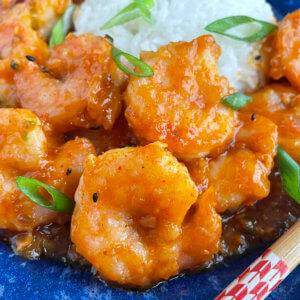
Ebi Chili – Shrimp in Spicy Sauce
Ingredients
- 12-15 shrimp shells and tails removed, deveined
- 1 tbsp cornstarch for washing the shrimp
For the marinade
- ¼ tsp kosher salt
- ¼ tsp white pepper
- 1 tbsp sake
- 1 tbsp cornstarch
For the cornstarch slurry
- 1 tbsp cornstarch
- 1 tbsp water
For the stir fry
- 2 tbsp neutral oil such as canola
- 1 inch piece ginger skin removed, minced
- 2 cloves garlic minced
- 1 scallion minced, white and green parts separated
- 3 tbsp ketchup
- 1 tbsp doubanjiang
- ½ cup chicken broth
- 1 tbsp sake
- 1 tsp sugar
- 1 tsp sesame oil
Instructions
Prepare the shrimp
- Remove the tails from the shrimp and devein them if necessary.
- Next wash the shrimp. Rub the shrimp in 1 tablespoon of cornstarch and then rinse them under cool water to remove all of the cornstarch.Washing the shrimp in cornstarch helps improve their texture and firm them up.
Marinate the shrimp
- Mix all ingredients for the marinade (salt, white pepper, sake, and cornstarch) in a medium bowl. Add the shrimp and massage the marinade into the shrimp. Set the shrimp aside, in the fridge, for 10 minutes to marinate.
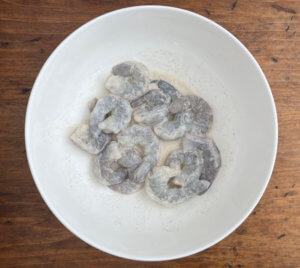
Fry the shrimp
- Heat 1 tablespoon of the oil in a wok or frying pan on medium-high heat.
- Once the oil is hot, add the shrimp to the pan and cook for 1-2 minutes on each side (for a total of 2-4 minutes) until the outsides of the shrimp are browned and crisp.

- Once finished, remove the shrimp from the pan and set aside. The insides of the shrimp do not need to be fully cooked through at this point.
Make the cornstarch slurry
- Mix 1 tbsp cornstarch with 1 tbsp of water and set aside.
Make the stir fry
- Clean the same wok or pan, return it to medium-high heat, and add 1 tablespoon of fresh oil.
- Once the oil is hot, add the ginger, garlic, and white parts of the scallion and cook for 1-2 minutes, stirring constantly, until lightly browned.
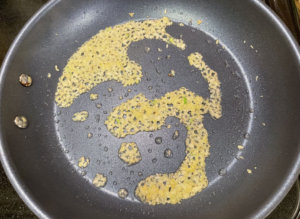
- Lower the heat to medium and add the ketchup and doubanjiang. Cook for 1-2 minutes, stirring constantly, until the ketchup and doubanjiang become fragrant.
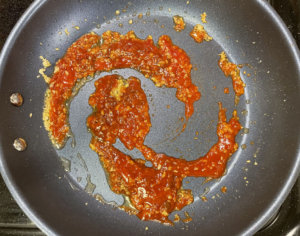
- Add the chicken broth, sake, and sugar, and simmer for 2-3 minutes, stirring frequently.
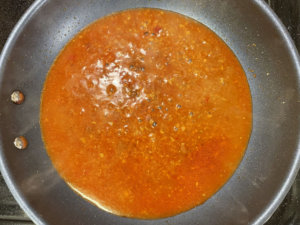
- Add the partially-cooked shrimp and the green parts of the scallions, and simmer until the shrimp are cooked through, about 1-2 minutes.

- The cornstarch slurry may have separated, so use a spoon to stir it again. Then add the cornstarch slurry to the pan and stir. Cook for 1-2 minutes until the sauce is thickened, stirring constantly.

- Add the sesame oil and stir. Remove the pan from the heat.
Serve
- Once finished, place the shrimp and sauce on a serving plate and enjoy.

This version of ebi chili is BOMB! Really, everything is perfect–the right proportions of piquant, sweet, spicy. Delightful. Yes, there are lots of ingredients, but no part of the recipe is harder than gathering all the parts and prepping. Fun to make–and gets rave reviews from those you serve it to.
Thank you Carolyn! I’m so glad you enjoyed it and that you also had fun making it! 🙂